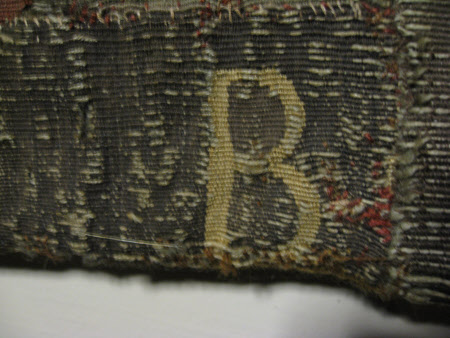Bacchanal (fragment)
English or Flemish
Category
Tapestries
Date
circa 1680 - circa 1710
Materials
Tapestry, wool and silk, 7-9 warps per cm
Measurements
1520 x 750 mm
Order this imageCollection
Packwood House, Warwickshire
NT 557835
Summary
Tapestry fragment, wool and silk, 7-9 warps per cm, Bacchanal, English or Flemish, c. 1680-1710. Fragment with naked boys playing. A boy stands on a plinth holding a bunch of grapes and pouring water from a jug onto the hand of his companion, who appears to struggle beneath his feet. A third boy with pointed ears grips the first boy’s leg. The boys are all executed in monochrome, imitating sculpture. The background is filled with leaves. At the bottom a separate piece of tapestry has been attached, bearing a large cartouche and on the galloon at the right the letter ‘B’, part of the mark of the city of Brussels, two capital 'B's either side of a red shield. A worn brown galloon has been attached around the other three edges.
Full description
This is a fragment of at least two other tapestries. The upper section is part of a larger piece representing ‘Bacchanals’ or playing boys, of which a complete example exists at Cotehele House in Cornwall (no. 348257). The panel at Cotehele has a group of boys playing with water jugs in the centre, in a landscape setting. The playing boys appear to be imitating the actions of a stone fountain on the left hand side of the composition, which is formed of a carved group of naked boys wrestling and holding water jugs. This carved fountain is exactly replicated in the fragment at Packwood. On the right hand side of the tapestry at Cotehele a section from another tapestry has been joined, showing a similar carved fountain, this time with only one boy holding a water jug. The panel at Cotehele forms part of a group of tapestries showing naked boys playing. There are two partial sets of this tapestry design at Cotehele, one with a narrow bead-and-reel border, and one with a wider border featuring acanthus leaves on a blue background. One of the acanthus leaf borders bears the mark used by Mortlake and later London weavers, of a white shield bearing a red cross of St George. Although these borders have in many areas been removed and re-attached, parts of them are integral, indicating that the ‘Bacchanals’ are of English origin. There are a number of other sets of Bacchanals following the same design in England, and they have been associated with the English tapestry weavers Thomas and Francis Poyntz, (Marillier 1930, pp. 24-26; Hefford 1992, p. 106). The conceit of contrasting real playing boys and sculpted ones in a tapestry demonstrates a playful approach appropriate to the subject of the tapestries themselves. In the context of tapestry design it also reflects an awareness of the relationship between tapestry and the other arts; in the ‘Bacchanals’ the weaver asserts the power of the tapestry medium, by conquering both nature (the boys) and art (the carved fountain). Unfortunately in the fragment at Packwood this effect is lost, as all we see is the representation in tapestry of a carved representation of boys at play. The lower section of the tapestry showing a large cartouche is not related to the Bacchanals. This is confirmed by the warp count of the two sections: the upper section has 7 warps per cm, the lower section 9 warps per cm. The cartouche is part of the lower border of a tapestry, and it still has its original galloon in which part of the Brussels town mark (two Bs either side of a plain red shield) is visible. (Helen Wyld, 2009)
Provenance
Given to the National Trust by Graham Baron Ash in 1941
Credit line
Packwood House, The Graham Baron Ash Collection (The National Trust)
Marks and inscriptions
Lower right: A single letter 'B', part of the mark of the city of Brussels, two capital Bs either side of a red shield
Makers and roles
English or Flemish , workshop Brussels , workshop
References
Hefford, 1991: Wendy Hefford, The Cotehele Tapestries, The National Trust, 1991 (n.p.), Not paginated Marillier, 1930: Henry C Marillier, English Tapestries of the Eighteenth Century, London 1930, pp. 24-26 Hefford, 1992: Wendy Hefford, 'Ralph Montagu's Tapestries', in Tessa Murdoch (ed.), Boughton House, the English Versailles, London 1992 , p. 106


